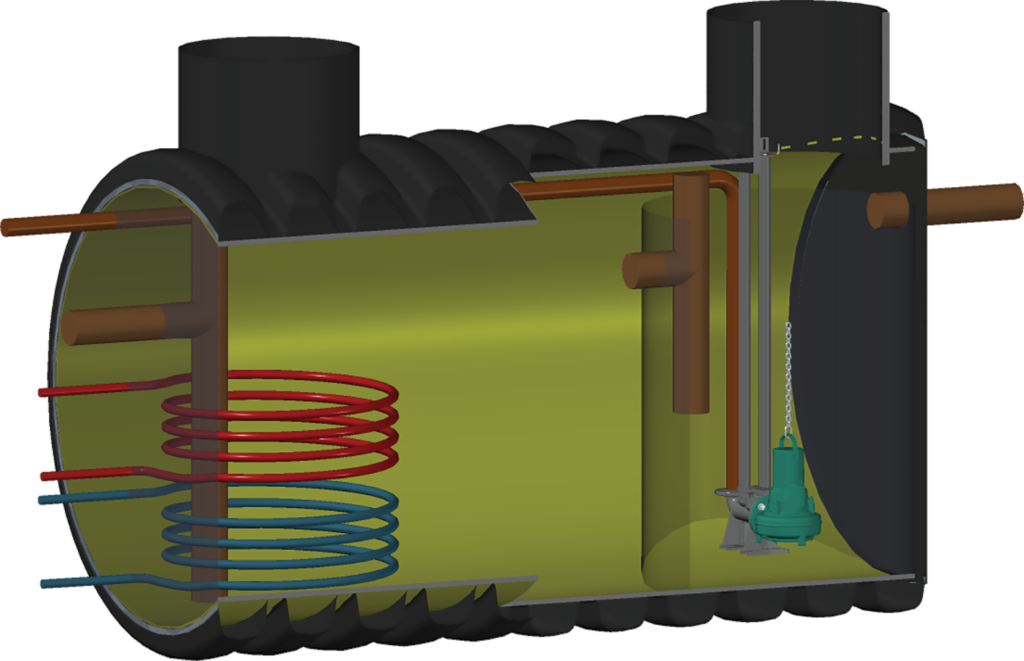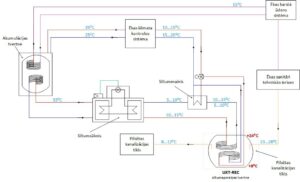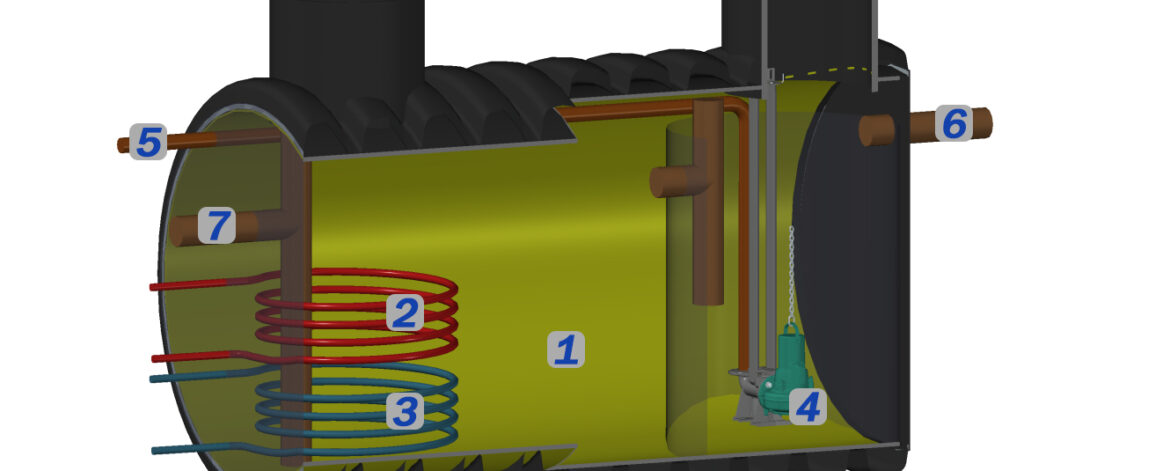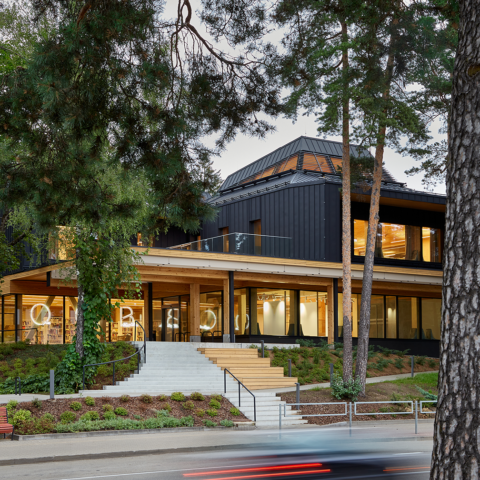
Wastewater from residential and public buildings, as well as industrial wastewater, has potential as a source of heat, not currently used for energy supply. We have developed and patented a technology to harness this hidden potential!
The system is intended as a source of energy, functioning as a provider of heating, hot water, and indoor cooling in houses, industrial facilities, food factories, etc. It requires a connection to a wastewater line, with at least 12 m3 of wastewater flow per 24 hours. This value depends on the chosen capacity of the system.
The demand for heating and cooling is not simultaneous, and wastewater serves both as a supplier of energy and as an accumulator. The operating efficiency of the device can be calculated with the inclusion of the heat pump, by adding the heat energy transferred to the building and the heat energy transferred as part of indoor cooling, divided by the electricity consumption required to power these processes.
System operating principles and benefits:
• The wastewater need not be treated before it is moved into the UKT-REC system;
• The system operates on its own and requires maintenance 1-2 times a year, without the need for trained staff;
• Finished systems can be installed on outdoor wastewater lines; smaller units are designed to be set up in the basement or at the foundation of the building, so that they receive the water before it is discharged into the district wastewater collection network;
• The power of different UKT-REC models ranges from 15 to 45 kW, and the size of the smallest unit is only 2 x 2 m.
Our UKT-REC system recovers the heat energy from wastewater and returns it to the consumer for heating and hot water production, while the wastewater cooled as a result of the process can be used to cool the inside of the building in free-cooling mode.
We also offer a patented solution adapted to the recovery of heat from the wastewater produced in fish farm pools.
Frequently asked questions
What does wastewater heat recovery mean, and how is it done?
Wastewater has heating potential, which can be harnessed efficiently before the wastewater is discharged into the wastewater collection system. UKT-REC can be installed at the outlet of the sewer systems of apartment buildings as well as on centralised wastewater lines. The small size of UKT-REC15, with a capacity of 15 kW, means it can be installed in basements.
Kā izskatās UKT-REC iekārta un kā tā darbojas?
Iekārta tiek piegādāta gatava montāžai, un tā sastāv no:
1. notekūdeņu akumulācijas tvertnes;
2. siltumsūkņa kontūra apkures (pievienojums ventilācijas/ rekuperācijas sistēmai) un karstā ūdens sagatavošanai;
3. brīvdzesēšanas kontūra iekštelpu dzesēšanas vajadzībām;
4. notekūdens cietās frakcijas atdalīšanas tvertne;
5. spiedvada pievienojuma notekūdens cietās frakcijas novadīšanai;
6. notekūdeņu ieplūde;
7. notekūdeņu izplūde.
The system receives wastewater with a temperature of +8 °C to +24 °C. The wastewater first enters the tank for the separation of solids and then goes into the accumulation tank. The tank has heat exchangers, recovering the heat and returning it to the environment, which in this case is the wastewater in the storage tank. The heat exchangers move the heat medium to the heat pump and the building’s heating, water treatment, and cooling equipment. In its installed form, the system has control software that adjusts and monitors its operation. UKT-REC can be equipped with a wastewater meter.
Can wastewater be used to make hot water?
The wastewater generated in the building is not sufficient to fully produce hot water if the indoor free cooling cycle is not working. The water in the heat accumulation tank can usually be heated up to +55 °C, and additional heat for producing hot water can be extracted from an underground circuit or boreholes, or provided by electricity. If electricity is used, the system can be equipped with the HeatTrail software module, which automatically tracks the price fluctuations on the electric power exchange during the operation of the system, if the consumer uses the dynamic price package for their electricity. This means that additional heating of hot water is done at the lowest power exchange price.
Can wastewater be used to cool indoor spaces and how effective is it?
Once the heat pump uses the heat exchange tank to transfer the heat potential of the wastewater to hot water and heating, the wastewater cools down. The patented S plus wastewater heat exchange technology makes it possible to use this cooled wastewater for indoor cooling, in free cooling mode.
The indoor cooling and hot water demand cycles do not take place at the same time. Demand for hot water peaks in the mornings and evenings, while indoor cooling peaks between the afternoon and evening. S plus technology enables the storage of wastewater in a heat exchange tank, so that it can accumulate both heat and cold, allowing the necessary potential to be used, with a time delay as needed. When cooling indoor spaces in free cooling mode, the cooling supply chiller is not used, improving indoor cooling efficiency by 8 to 12 times.
Contact us
Choose the capacity of the heat pumps for your building and let us know so that we can offer you a cost estimate!
Visit us:
Ikšķile, Skolas iela 15, Latvia
Message us:
Call us:













